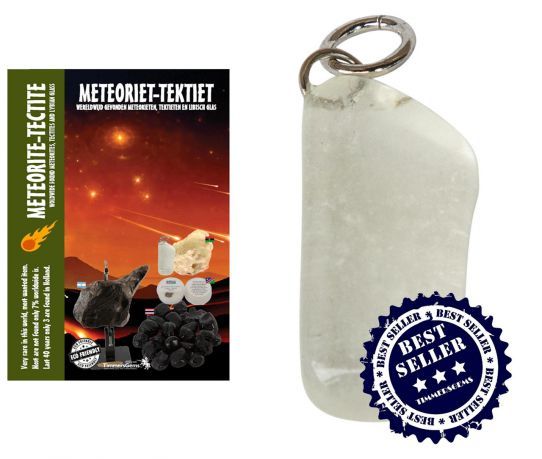We use cookies to make your experience better.
Libyan desert glass "eyes" pendant from Egypt.
Libyan desert glass (LDG), or great sand sea glass is a substance found in areas in the Libyan Desert. Fragments of desert glass can be found over areas of tens of square kilometers. Tektites (from Greek τηκτός tēktós, "molten") are gravel-size bodies composed of black, green, brown or gray natural glass formed from terrestrial debris ejected during meteorite impacts. They generally range in size from millimeters to centimeters. Millimeters-size tektites are known as microtektites. Although tektites are superficially similar to some terrestrial volcanic glasses (obsidians), they have unusual distinctive physical characteristics that distinguish them from such glasses. First, they are completely glassy and lack any microlites or phenocrysts, unlike terrestrial volcanic glasses. Second, although high in silica (>65 wt%), the bulk chemical and isotopic composition of tektites is closer to those of shales and similar sedimentary rocks and quite different from the bulk chemical and isotopic composition of terrestrial volcanic glasses. Third, tektites contain virtually no water (<0.02 wt%), unlike terrestrial volcanic glasses. Fourth, the flow-banding within tektites often contains particles and bands of lechatelierite, which are not found in terrestrial volcanic glasses. Finally, a few tektites contain partly melted inclusions of shocked and unshocked mineral grains, i.e. quartz, apatite, and zircon, as well as coesite. The difference in water content can be used to distinguish tektites from terrestrial volcanic glasses. When heated to their melting point, terrestrial volcanic glasses will turn into a foamy glass because of their content of water and other volatiles. Unlike terrestrial volcanic glass, a tektite will produce only a few bubbles at most when heated to its melting point, because of its much lower water and other volatiles content.
A meteorite is the part of a meteoroid impinges after it on the earth from space to have fallen through the atmosphere. During the trip through the atmosphere, the material is greatly slowed and very hot; this can be seen as a meteor. Essentially, a meteorite debris from space. On the basis of the composition of meteorites can sometimes be determined what the source is. For example, there are already more than twenty were found which are derived from the moon. This refers to material that another meteorite from the moon's out of control. There are also meteorites, such as ALH84001 found whose origin is Mars. In many cases, however, the meteorite came from the asteroid belt (also called asteroid belt) between Mars and Jupiter. Whether there meteorites consist of a cometary origin, is still under discussion. It is possible that some rare and very fragile species of carbonaceous meteorites of short-period comets originate. A lot of debris that comes in contact with the atmosphere does not reach the earth, but burns by the resistance of the atmosphere. The fragments that burn in the night visible as meteors, also called star rain or shooting star. For larger items that do not completely burn only partially as meteorites land on Earth, occurs when passing the atmosphere a bolide (fireball). That it can be an impressive phenomenon is apparent in the car of the Sikhote-Alin. That was very visible in full daylight. The fireball caused by the Dutch Glanerbrug meteorite from April 1990, just before sunset was visible.












